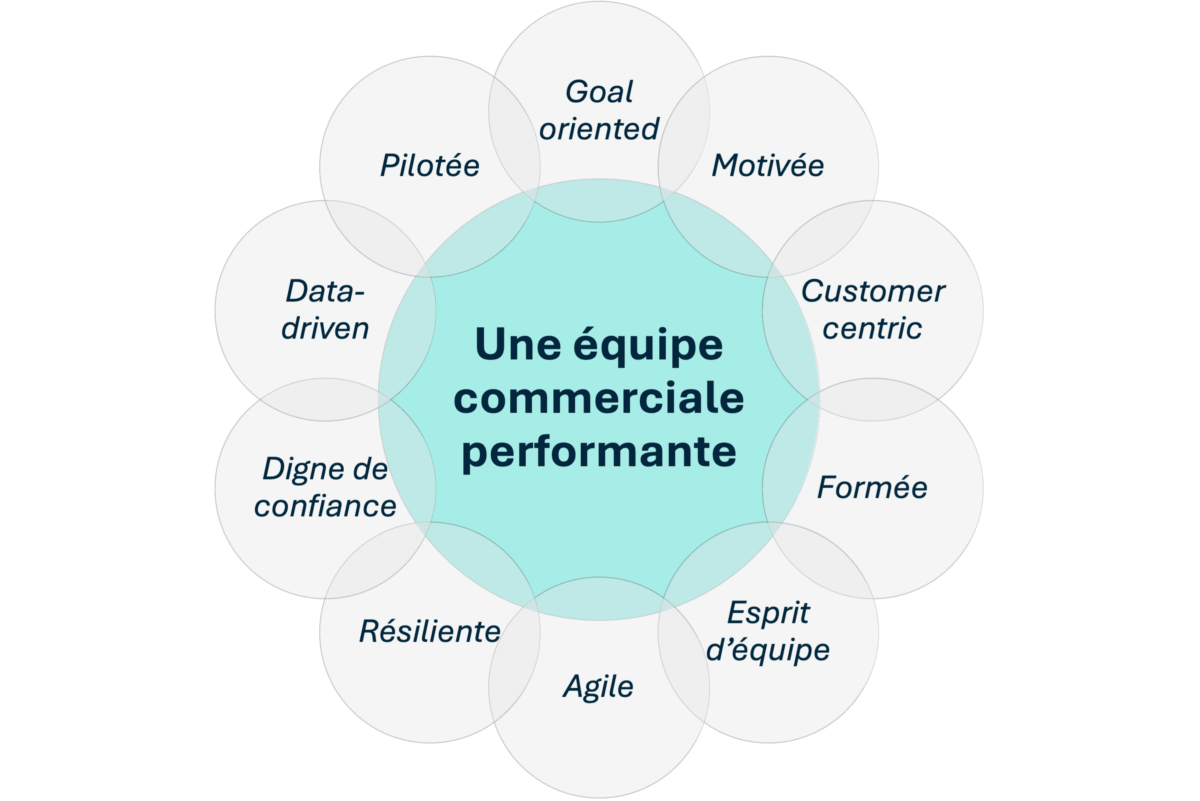
Blog

Leading a sales team effectively means making it successful with a dynamic, agile organization that produces the best possible sales reps results. Since each sales activity has its own team, market, offers and products, the right kind of leadership is a science that needs to be adapted on a case-by-case basis if it is to work. Encouraging, supporting, training and equipping are common components of winning strategies. The evolution of the sales function places Marketing at the heart of the animation challenge, and reinforces its importance.
Why lead a sales team?

A recent Uptoo study reveals that 77% of sales reps believe it is urgent to modernize their company's sales techniques. This figure is explained by the evolution of their appointments(Modern Selling) and the new expectations of buyers. Software, content, storytelling, agility and a personalized approach are now at the heart of the assets mastered by the best! In this evolution, the Marketing Department is becoming a key player in feeding and coaching sales teams. Marketing needs to be massively fed with information from the field to enable it to adjust its input to sales reps : content to sell, animation, training, information, and so on.
With the means to adjust its contribution to sales performance, marketing needs to find the best way of communicating and making a success of the sales team's day-to-day activities. This is precisely the role of sales animation. Animating a sales team means creating a positive and coherent dynamic around a corporate objective, then supporting it with appropriate resources such as training, coaching or sales content... The idea is to create a high-performance sales team, capable of evolving in this complex B2B sales environment! What are the main characteristics of high-performance sales teams? They are : Goal-oriented, motivated, customer-centric, trained, collaborative, agile, resilient, trustworthy, data-driven, driven.

The different ways to lead a sales team

An effective sales promotion must make the sales team successful by activating the characteristics specific to its activity.
1 - Mastering content to sell
Marketing content is essential for a successful sales meeting. It helps contextualize the salesperson's message and personalize the approach to the buyer. During a sales meeting, the salesperson is not simply expected to distribute or comment on the content at his or her disposal; he or she must be able to embody the marketing message and give it meaning. Marketing must therefore not only take into account the need to design content to sell, but also take responsibility for developing the skills of its teams in the associated discourse. Ensuring that an offer/service is mastered by the salesperson means ensuring that the marketing strategy is aligned with the field teams, and that it will be understood by buyers during meetings.
Alban Duron, Marketing Director France - JCDecaux "A unique solution that outlines the brand's general message but leaves it up to each individual to adapt & find the most relevant path for each customer".
Mastering content is a relatively cross-functional means of positively impacting several components of sales performance: motivation, agility, resilience, customer-centricity, objectives, and so on.
2 - Challenges sales reps
The sales function alternates between moments of great satisfaction and background work that can be tedious. Motivating sales teams with a sales challenge helps to create excitement and motivation both during intense phases of sales activity and during slower ones. The aim of this operation is to boost sales over a given period in order to improve overall sales performance. The sales challenge is an effective way of motivating a sales team, particularly during one-off operations. Whether you're launching a new product, boosting sales during an off-peak period, or organizing a special event (B2B trade shows, door-to-door canvassing, etc.), a sales challenge is an excellent way of motivating your sales team. sales reps also have a significant impact on several aspects of sales performance : motivation, team spirit, resilience, customer-centricity, objectives, etc.
3 - Individual objectives
Beyond team challenges, personalizing objectives helps to give meaning and determination to sales reps. Setting objectives is essential to leading a sales team. They align teams with the company's overall strategy and steer their actions in the right direction. By setting clear, measurable objectives, you motivate sales reps to achieve them. By ensuring that objectives are SMART: Simple, Measurable, Acceptable, Realistic and Time-bound, you ensure their relevance. These objectives serve as yardsticks for providing the feedback and accountability needed to improve the salesperson's day-to-day performance. Individual objectives have a positive impact on performance in the following areas: goal attainment, motivation, customer-centricity, day-to-day agility, resilience, confidence, team management, etc.
4 - Training & coaching
Knowing how to manage sales reps ' growing competence in mastering the content available to them, the associated pitch, the different ways of using or adjusting this content, etc. is a formidable performance lever. Training is regularly reduced to in-situ training time, naturally restricted by the cost associated with the operation. Yet the needs of sales reps are increasing as their role evolves. We therefore need to make training as fun, targeted, varied, available and personalized as possible. Whether for new recruits or more experienced sales reps , developing expertise across the entire sales population is a major challenge for any sales & marketing department wishing to improve its sales performance. Leading a sales team effectively involves personalized training programs, individual and group meetings, and coaching sessions to encourage team cohesion. It's really a matter of implementing effective collective operating methods. The use of gamification mechanisms or quizzes in training is an excellent way of motivating and reinforcing the commitment of sales reps.
5 - Sales Tech
Sales Tech brings together all the technological tools designed to support and optimize sales activities. Using them to manage a sales team offers numerous advantages: Sales x Marketing alignment, time savings, sales process optimization, improved sales activity management, greater transparency and traceability thanks to KPIs, training content accessible to the sales force, and reinforced synergies between sales & marketing teams. Each phase of the sales function has its own dedicated tools, which can be more or less relevant to your business: prospecting assistance, sales follow-up assistance, personalized content, offer generator, etc. A good CRM and a high-performance Sales Enablement platform remain fairly universally strategic for sales activity, impacting all performance segments.
Leading a sales team: what's at stake for sales & marketing managers?

1 - Increase in sales
Increasing sales is obviously one of the main objectives of sales promotion. To increase sales, it is essential to have a high-performance sales team. The performance of this sales team will largely depend on its sales skills and the environment in which it operates. Leading a sales team therefore involves providing marketing content aligned with the needs of the field, effective onboarding, ongoing training and tools based on data analysis to improve sales performance.
Vianney Leveugle, Marketing & Sales Director - GEODIS "Offers are better mastered by sales reps, and therefore better understood by customers, which leads to higher sales ".
2 - Improved customer satisfaction
A Growth Strategies International survey showed that :
- A "very satisfied" customer contributes 2.6 times more to a company's revenues than a "fairly satisfied" one.
- A "very satisfied" customer contributes 17 times more to the company's revenues than a "rather dissatisfied" one.
- A "very dissatisfied" customer reduces the company's revenues at a rate 1.8 times higher than a "satisfied" customer.
Customer satisfaction is therefore naturally at the heart of your sales performance strategy. Several elements contribute to this satisfaction, upstream of the sale, and have a significant impact on the perception of the service/product. To be successful, the meeting must be truly customer-centric. The presentation and sales pitch must be tailored to the specific buyer, as must the answers to his or her questions. The salesperson must act as a "sense-maker", helping the buyer to make informed decisions. He or she must be perceived as a trustworthy player, and be able to create the long-awaited appointment experience. 81% of corporate buyers say that the sales experience offered by a supplier is as important as its products and services (Salesforce).
3 - Reducing sales force turnover
According to G2 Learn, if your sales reps don't feel they are learning and developing within your organization, you risk losing over 60% of your entire workforce within four years. Accelerating the up-skilling of new entrants and continuously training the sales force is therefore becoming a priority for companies wishing to reduce the costs associated with recruiting and training new employees. Certain characteristics such as resilience, motivation and team spirit will have an impact on the loyalty and commitment of sales reps. Knowing how to lead a sales team effectively is therefore a decisive factor in reducing turnover and improving sales reps ' satisfaction with their role.
Eric Jayet, Performance Director - Adéquat Group " Used in the integration process and then in the salesperson's day-to-day work, Salesapps has enabled us to reduce the turnover of our sales reps by 30% over 1 year. "
What profiles are needed to lead a sales team?

1 - Operational Marketing Manager
The role of the Operational Marketing Manager is to facilitate and optimize the work of sales reps. He or she is driven by the need to transform the sales approach and understand the environment in which field teams operate. He or she is responsible for distributing marketing content to all sales teams, to make them more effective during meetings. This is an important role, as it means giving marketing content greater impact and making it easily accessible.
2 - Sales Force Development Manager
The Sales Development Manager is responsible for managing and leading the sales team. He/she participates in the development of sales reps ' sales pitches and implements training and stimulation programs for the sales force. To this end, he/she has tools at his/her disposal to encourage, motivate and support sales reps in achieving their objectives.
3 - Marketing & Communication Manager
In some cases, the Marketing & Communication Manager may be involved in sales promotion. The sales force is a powerful vector of communication for a company, since it is in direct contact with the buyer. Their role is to ensure that marketing messages are delivered quickly and effectively to teams in the field.
4 - Marketing & Sales Manager
The Marketing & Sales Director may have a role to play in animating thesales team, particularly during the high points of certain operations. In the case of a new product launch, for example, he'll want to make sure that his team has mastered the sales pitch, and may also issue reminders before the big day. During the operation, he ensures that it runs smoothly, that marketing content is used, and may motivate teams by region with incentives. Afterwards, he will take an ROI-based approach to evaluate the success of his operation.
Sales Enablement for effective sales team management!

1 - Maintain constant, effective communication
Aligning sales and marketing through a Sales Enablement tool ensures real-time information sharing and constant communication between head office and field teams. By ensuring fluid and transparent communication, Sales Enablement enables sales reps to be constantly informed of the latest updates concerning offers/services, company news or any other information required for their activity. To reinforce this communication, the marketing team can animate a sales team using push notifications. These notifications can be targeted to different user groups or sent by name, ensuring that each sales reps receives relevant information. They can include links to content, interactive tiles, quizzes or news, giving sales reps quick and easy access to resources and information essential to their day-to-day work.
The Sales Enablement application goes a step further by enabling permanent contact to be maintained with teams in the field. Communication is not just one-way, it's also bottom-up, facilitating feedback from the field. Competitive observations, suggestions for improvement, customer feedback, business opportunities - all information can be shared quickly, in any format (from a simple free-text note to a form, or even photos) and sent to the right people. The good news? sales reps also find real added value in field feedback via the Sales Enablement application. Thanks to the gamification system integrated into the application, sales reps can be awarded badges/points based on the number of photos shared, the number of likes on a photo, but also on the way in which field feedback is carried out.
2 - Ensuring that all available offers/services are fully taken on board
Ensuring that marketing content is taken in hand means ensuring that this content is always at sales reps ' fingertips! Today, 90% of the content developed by marketing teams for sales reps goes unused (Forrester). Instead of relying on a document base specially designed for them, sales reps spend more than 7 hours a week researching or producing their own content (Salesforce). By centralizing marketing content in a Sales Enablement application, you can simplify their lives! Not only is the content accessible in 100% offline mode, but they always have the latest, most up-to-date version, accessible on all their devices (PC, tablet and cell phone). This means that sales staff can concentrate on their appointments, engage their buyers with the best version of the media available, and make the most impact in front of the buyer. As marketing content is integrated into sales paths, they can personalize their approach, contextualize what they say, and have a greater impact in meetings.
The use of marketing content by the sales force could increase by 30% if marketing teams integrate feedback from the field (Forrester). In effect, the salesperson can pass on a specific message to the marketing departments (photo or other type of content) during or after an appointment. The strength of a Sales Enablement application also lies in its ability to adapt to the particularities of each company. No matter how much content is integrated, the search space makes it easy for sales reps to find the latest, most consulted or simply the content they want.
3 - Organizing training around sales teams
Efficient training of sales reps means training them from the moment they join the company, at regular intervals or even on a daily basis. In addition to conventional training, sales reps need to be provided with constantly updated training materials that can be accessed at any time of day, whether on a PC, tablet or cell phone. The Sales Enablement application enables sales reps to train continuously and at their own pace. They can test their knowledge using a quiz format, whether they're on the move, with customers during waiting periods, working from home or at the office. Any time is a good time for training, so it's essential to adapt the process accordingly. Sales Enablement's application goes one step further, offering marketing managers the opportunity to gamify the training experience with badges, scores and personalized levels. By making learning fun and enjoyable, sales reps will be more inclined to train naturally and continuously. The notification and alert systems in the Sales Enablement application also enable the marketing team to inform the sales force in real time of the availability of new materials, which can boost their activity. Leading a sales team becomes child's play for the marketing team, and team skills are enhanced!
4 - Control and monitor sales activity
Because monitoring your activity is vital to the success of your sales performance, your Sales Enablement platform must offer you a KPI dashboard. This dashboard enables you to easily manage and pilot your activity. Whether it's tracking the sales journey of your sales reps in appointments, analyzing your statistics (per session, per user, per video/document viewed and shared) or monitoring the skills development of your sales force... you benefit from all the data you need to understand the environment in which your company operates and can improve the practices of your sales reps in appointments. The Salesapps back office, for example, integrates a range of advanced functionalities to help you animate your sales team. With push notifications, surveys, quizzes, news and gamification mechanisms, you'll have everything you need to energize and manage your sales team effectively.
Join Salesapps ENGAGE, to be informed of our upcoming events.
FAQ
How do you define sales team leadership? Leading a sales team consists in creating a positive and coherent dynamic around a corporate objective by supporting team members with resources such as training, coaching and sales-oriented content. The aim is to create a favorable environment for achieving sales reps objectives.
Which profiles are responsible for leading a sales team? Profiles in charge of leading a sales team include Operational Marketing Manager, Sales Force Development Manager, Marketing & Communication Manager and Marketing & Sales Director.
What are the tools for leading a sales team? There are many tools available to drive a sales team: sales content, sales reps challenges, individual incentives, training and coaching.
Why animate a sales team with a Sales Enablement application? Leading a sales team with a Sales Enablement application offers a number of advantages, including: ensuring ongoing, effective communication between sales and marketing teams, guaranteeing that sales reps get to grips with marketing content, organizing training around sales teams in an interactive, personalized way, monitoring and tracking sales activity in real time to effectively steer the sales team.



